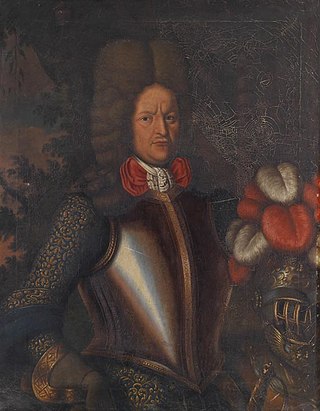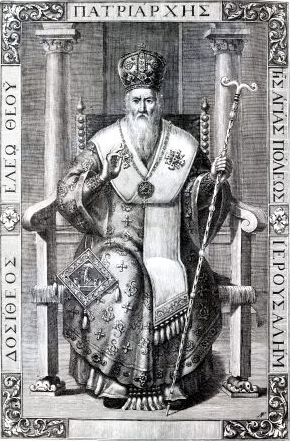| |||||
| Decades: | |||||
|---|---|---|---|---|---|
| See also: | |||||

Events from the year 1707 in Russia:
| |||||
| Decades: | |||||
|---|---|---|---|---|---|
| See also: | |||||

Events from the year 1707 in Russia:
| | This section needs expansion. You can help by adding to it. (October 2015) |
| | This section needs expansion. You can help by adding to it. (October 2015) |
| | This section needs expansion. You can help by adding to it. (October 2015) |
The second millennium of the Anno Domini or Common Era was a millennium spanning the years 1001 to 2000. It began on 1 January 1001 (MI) and ended on 31 December 2000 (MM),.

Catherine IAlekseevna Mikhailova was the second wife and empress consort of Peter the Great, and empress regnant of Russia from 1725 until her death in 1727.
Queen Anne can refer to:

The Battle of Poltava was the decisive and largest battle of the Great Northern War. A Russian army under the command of Tsar Peter I defeated a Swedish army, under the command of Carl Gustaf Rehnskiöld. The battle put an end to the status of the Swedish Empire as a European great power, as well as its eastbound expansion, and marked the beginning of Russian influence in Northern Europe.
A reign is the period of a person's or dynasty's occupation of the office of monarch of a nation, of a people or of a spiritual community. In most hereditary monarchies and some elective monarchies there have been no limits on the duration of a sovereign's reign or incumbency, nor is there a term of office. Thus, a reign usually lasts until the monarch dies, unless the monarchy itself is abolished or the monarch abdicates or is deposed.

Johann Reinhold Patkul was a Livonian nobleman, politician and agitator of Baltic German extraction. Born as a subject to the Swedish Crown, he protested against the manner of King Charles XI of Sweden's reduction in Livonia, enraging the king, who had him arrested and sentenced to mutilation and death (1694). Patkul fled from the Swedish Empire to continental Europe, and played a key role in the secret diplomacy (1698-1699) allying Peter I of Russia, Augustus II the Strong of Saxony and the Poland–Lithuania - as well as Christian V and his successor Frederick IV of Denmark–Norway - against Charles XII of Sweden, triggering the Great Northern War of 1700-1721. Patkul was close friends with the Danish Privy Councillor Knud Thott who had been driven away from his home province Scania during the Scanian War. During the 1690s and early 1700s the two of them worked actively for Danish intervention against Sweden so that Livonia and Scania might be freed from Swedish overlordship. During the first war years, Patkul retained a key role in the communication between the allies and other European courts, holding positions at king Augustus's court first in Augustus's interests (1698-1700), then in tsar Peter's service. In late 1705 Patkul fell from Augustus's favor and was arrested and charged with high treason. Throughout the following year he was detained first in Sonnenstein, then in Königstein, before Charles XII forced Augustus to extradite him by the Treaty of Altranstädt in late 1706. Patkul spent another year in Swedish detention before Charles XII had him broken on the wheel and decapitated.

The Parliament of Great Britain was formed in May 1707 following the ratification of the Acts of Union by both the Parliament of England and the Parliament of Scotland. The Acts ratified the treaty of Union which created a new unified Kingdom of Great Britain and created the parliament of Great Britain located in the former home of the English parliament in the Palace of Westminster, near the City of London. This lasted nearly a century, until the Acts of Union 1800 merged the separate British and Irish Parliaments into a single Parliament of the United Kingdom with effect from 1 January 1801.
A personal union is the combination of two or more states that have the same monarch while their boundaries, laws, and interests remain distinct. A real union, by contrast, would involve the constituent states being to some extent interlinked, such as by sharing some limited governmental institutions. Unlike the personal union, in a federation and a unitary state, a central (federal) government spanning all member states exists, with the degree of self-governance distinguishing the two. The ruler in a personal union does not need to be a hereditary monarch.

Prince Michał Serwacy Wiśniowiecki was a Lithuanian nobleman, magnate, politician, diplomat, general, a successful military commander and the last male representative of the Wiśniowiecki family.
Admiralty most often refers to:

The Kingdom of Imereti was a Georgian monarchy established in 1455 by a member of the house of Bagrationi when the Kingdom of Georgia was dissolved into rival kingdoms. Before that time, Imereti was considered a separate kingdom within these Kingdom of Georgia, of which a cadet branch of the Bagrationi royal family held the crown.

Louis Rudolph, a member of the House of Welf, was Duke of Brunswick-Lüneburg and ruling Prince of Wolfenbüttel from 1731 until his death. Since 1707, he ruled as an immediate Prince of Blankenburg.

The Bulavin Rebellion or Astrakhan Revolt was a war which took place in the years 1707 and 1708 between the Don Cossacks and the Tsardom of Russia. Kondraty Bulavin, a democratically elected Ataman of the Don Cossacks, led the Cossack rebels. The conflict was triggered by a number of underlying tensions between the Moscow government under Peter I of Russia, the Cossacks, and Russian peasants fleeing from serfdom in Russia to gain freedom in the autonomous Don area. It started with the 1707 assassination of Prince Yury Vladimirovich Dolgorukov, the leader of Imperial army's punitive expedition to the Don area, by Don Cossacks under Bulavin's command. The end of the rebellion came with Bulavin's death in 1708.

A naval ensign is an ensign used by naval ships of various countries to denote their nationality. It can be the same or different from a country's civil ensign or state ensign.
Events from the year 1678 in Ireland.

The military history of the United Kingdom covers the period from the creation of the united Kingdom of Great Britain, with the political union of England and Scotland in 1707, to the present day.

Dositheus II Notaras of Jerusalem was the Greek Orthodox Patriarch of Jerusalem between 1669 and 1707 and a theologian of the Eastern Orthodox Church. He was known for standing against influences of the Roman Catholic and Protestant churches. He convened the Synod of Jerusalem to counter the Calvinist confessions of Cyril Lucaris.

The Swedish invasion of Saxony took place in 1706 during the Great Northern War, which began in 1700 when Russia, Denmark–Norway, and Saxony attacked Sweden or its ally, Holstein-Gottorp. To force Augustus II the Strong out of the war, who was the electorate of Saxony and king in the Polish–Lithuanian Commonwealth, Charles XII of Sweden invaded the Commonwealth; Augustus was dethroned in 1704, and, after a devastating Saxon defeat at Fraustadt, Charles XII marched against Saxony in 1706 with 20,000 men.
![]() Media related to 1707 in Russia at Wikimedia Commons
Media related to 1707 in Russia at Wikimedia Commons